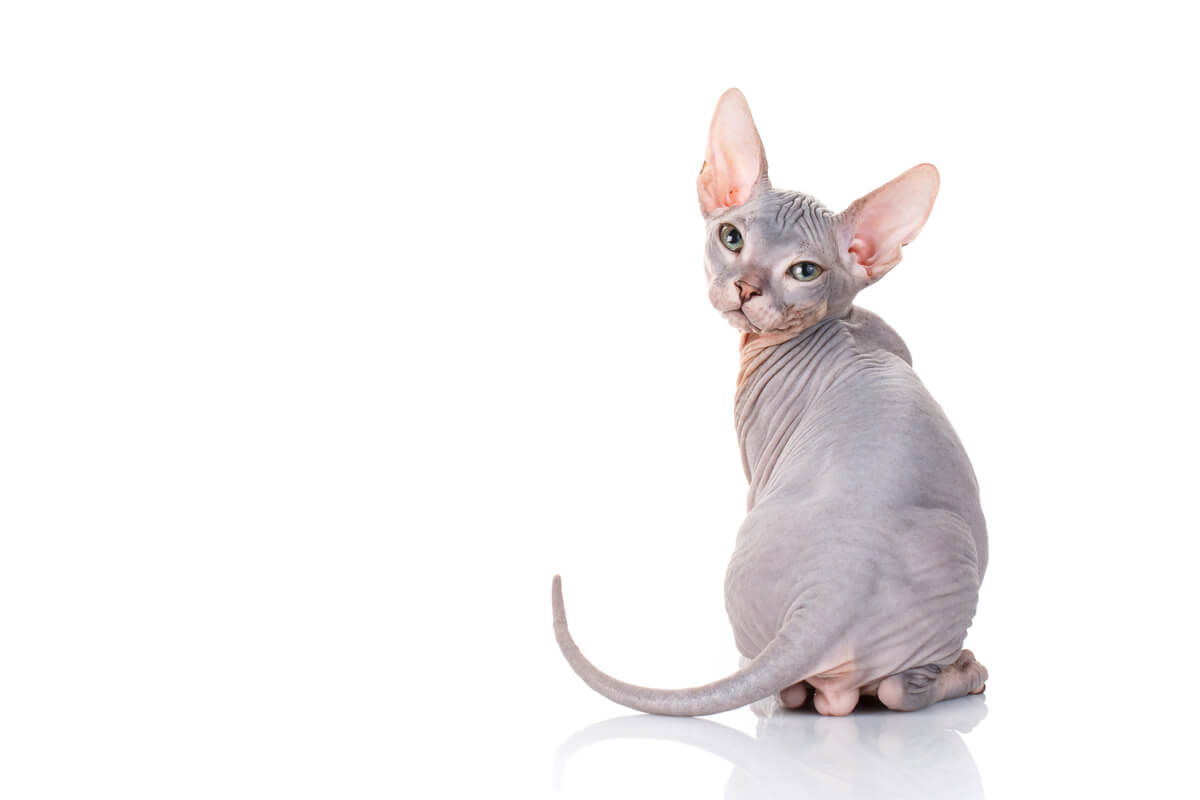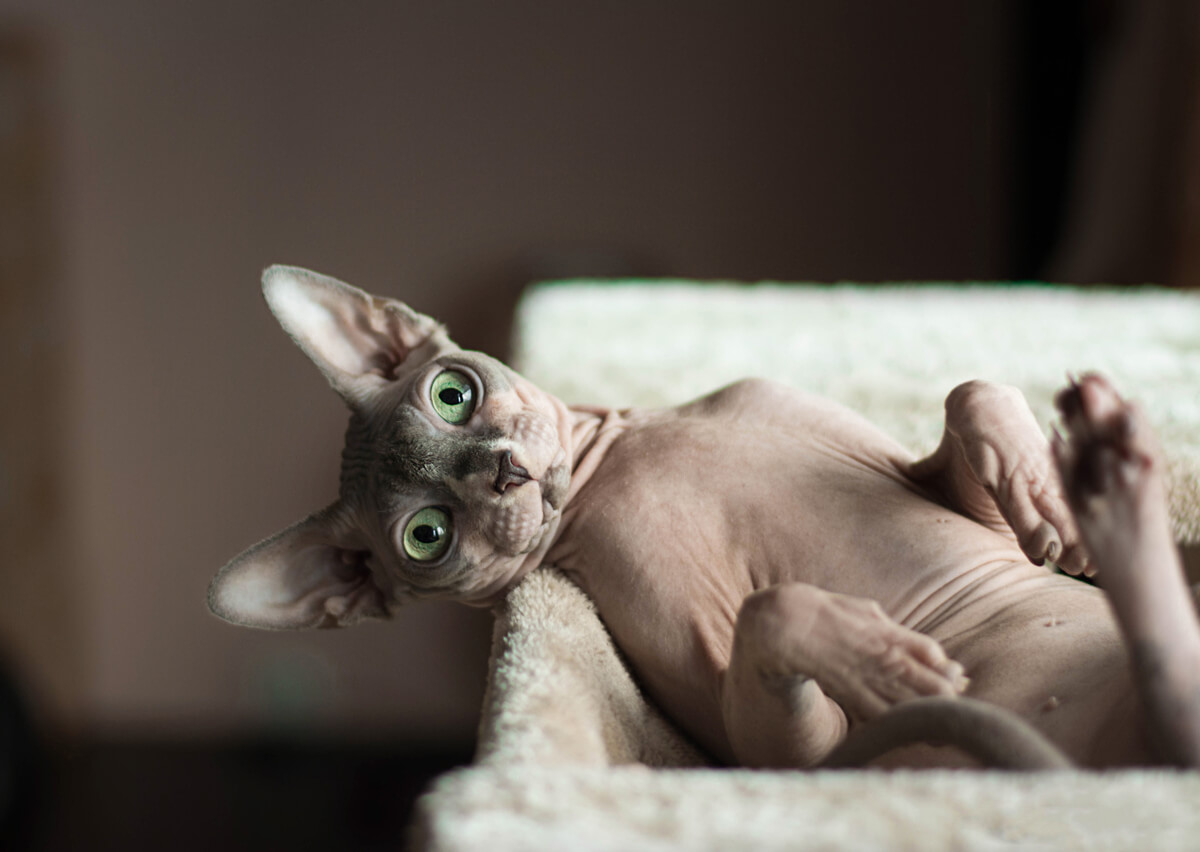How to Bathe a Sphynx or Hairless Cat


Reviewed and approved by the biologist Samuel Sanchez
Despite the fact that their hair is apparently non-existent, every owner should know that it’s still important to bathe a Sphynx or hairless cat. The hygiene of these animals is extremely important.
Grooming must be constant, as sweat, sebaceous secretions and dirt accumulate on the skin of this animal more than in other felines. In this article, you’ll learn the most important things about how to bathe a Sphynx or hairless cat.
The sphynx cat
The breeding of the Sphynx, or Egyptian cat began in Canada in 1966. It’s a robust animal and weighs between 3 and 6 kilos. Their skin has wrinkles and it can be of various colors. Not having hair isn’t a defect or a disease, because, although they appear bald to the naked eye, Sphynx are covered with a fluff that makes them feel silky, similar to the texture of a peach.
They’re very friendly, sociable, affectionate, and playful, and enjoy the company of humans and animals. However, they suffer greatly if they feel neglected. Also, this cat isn’t the only one without hair. Although it’s the best-known breed, experts tell us that that there are others, such as the Donskoy, Peterbald, Goblin, Ukrainian Levkoy, and the Dwelf.

Cleaning is essential
Apart from the basic care that every cat needs —periodic checks at the veterinarian and following a vaccination schedule, among others— this particular feline is usually very dependent on its owner. This is due to the demanding grooming routines it requires.
We know that all cats look after their own hygiene. However, hairless cats produce a lot of sebum when they sweat, and their skin needs to be cared for and cleaned. This also includes their ears, eyes, nails, and teeth. For this reason, it’s very important that you get your Sphynx used to bathing from a young age, as cleaning will form a very important part of its life.
How to bathe a sphynx or hairless cat?
Experts recommend bathing these cats once every 2 to 4 weeks. To do this, keep the following points in mind:
- Use a bathtub or bucket that the cat can fit into easily and put a towel on the bottom so it doesn’t slip. The water shouldn’t cover it at any time.
- As they have sensitive skin, it’s important that you use warm water. They’re delicate animals that don’t respond well to high and low temperatures, and they can easily catch a cold or burn. Remember that the layer of hair that protects them is very thin.
- Wet the cat little by little, so they don’t get nervous. Be careful not to get their head wet.
- Lather it gently and then rinse their skin with plenty of water.
- Use a damp cloth to clean their head and avoid getting water into their nose, eyes, and ears.
During the bath, you can create a relaxing atmosphere with music for cats, caresses, and fragrances specific to them. Avoid yelling or loud voices. At the end of the grooming, pat the cat dry with a towel and give it a treat as a prize.
What shampoo should you use to bathe a sphynx or hairless cat?
We recommend that you look for a specific shampoo for hairless cats or cats with sensitive skin. The most important thing is not to use products for humans or other animals. To make sure, we recommend asking your veterinarian.
Alternatives for the bathroom
The oily textured sebum produced by its skin is healthy and natural. This serves to protect and lubricate it. Therefore, very frequent baths aren’t recommended by some professionals, as we would eliminate these essential oils that protect and hydrate them. In this case, its skin would begin to produce them in greater quantity and irritations would appear.
Although a frequency of bathing of between 20 to 40 days is recommended, this depends on each cat. Pay close attention to the signs to know whether to bathe them more or less frequently and don’t hesitate to consult a professional.
If their skin takes on a reddish color, you should give them less intense baths. If you see grime or dirt in the small folds of their skin – which can cause dermatitis, scabies and other dermatological diseases – you should alternate the bath with another type of cleaning, such as wet cloths.
Also, if your cat is afraid of water, this isn’t a reason to neglect its hygiene. For these cases, there are cat wipes, although you can also clean their skin with the aforementioned wet cloths.
Cleaning of eyes, ears, nails, and teeth
You should avoid wetting the cat’s eyes and ears when you’re giving it a bath. However, this shouldn’t be an excuse not to bathe it, as it’s also essential that it has good hygiene. Keep these final tips in mind.
Their eyes have no lashes
With no eyelashes, more dirt or specks of dust will get into the sphynx’s eyes. Therefore, its tear fluid is able to prevent diseases. It’s recommended to clean their eyes once a week with a saline solution and sterile gauze, using a new one for each eye.
Their ears produce a lot of wax
As they are (almost) hairless cats and have very large ears, they get more dirt and accumulate a lot of wax in their ears. To clean them, use a new gauze for each ear with the help of your finger or some cotton swabs to gently clean the most superficial areas.
Caring for their nails and teeth
As we already mentioned, the sebum and sweat produced by these cats is higher, therefore their nails also tend to accumulate grease and dirt, also due to their lack of hair. To maintain the hygiene of your Sphynx cat, it’s advisable to cut their nails – just the tip – and clean them regularly.
When it comes to teeth, the Countryside Veterinary Clinic notes that sphynxes often have serious problems with their teeth. Therefore, they suggest that you brush them at least 3 times a week.

In addition to keeping them clean, we recommend that you keep your house clean, along with the bed where the cat rests, and the surroundings. As you’re living with a hairless cat, you must do everything to avoid dirt and bacteria.
All cited sources were thoroughly reviewed by our team to ensure their quality, reliability, currency, and validity. The bibliography of this article was considered reliable and of academic or scientific accuracy.
Caro, G. (2020, 24 agosto). 15 cuidados básicos para tu gato sin pelo. MuyInteresante.es. https://www.muyinteresante.es/mascotas/fotos/cuidados-basicos-para-el-gato-sin-pelo/8
Countryside Veterinary Clinic. (2019, 20 febrero). Sphynx. https://www.countrysideveterinaryclinic.org/services/cats/breeds/sphynx
De Gatitos. (s. f.). Gato Egipcio. Recuperado 24 de junio de 2021, de http://www.degatitos.org/gato-egipcio/
Echa una pata. (2020, 3 noviembre). ֎ Gatos Sin Pelo: Información, Imágenes Y Características ▷ 【 2021 】. EchaUnaPata.org. https://echaunapata.org/gatos-sin-pelo-informacion-imagenes-y-caracteristicas/
Gato en casa. (2020, 17 abril). 🐾 Gato egipcio: como es, sus cuidados y mas. https://gatoencasa.org/gato-egipcio/
Los Animales. (2018, 4 mayo). El Sphynx ▷ El Gato Esfinge sin Pelo más Famoso | LosAnimales.org. https://www.losanimales.org/gatos/sphynx/
This text is provided for informational purposes only and does not replace consultation with a professional. If in doubt, consult your specialist.